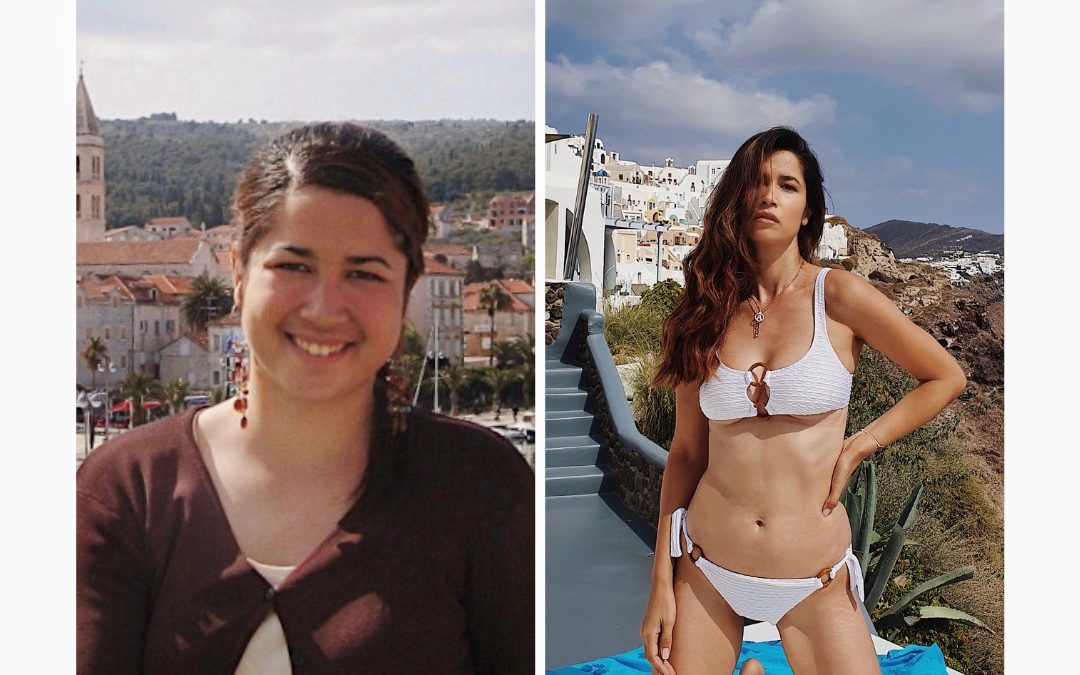So the picture on the left was the professional – yet chubby- tennis player Anja.
My physical appearance wouldn’t probably reveal to you that I practiced almost every day for like 3-4 hours. Looking back at this pic, it certainly proves that you can workout as much as you want – if your eating habits are not right – you can’t expect to be a more healthy and fit version of yourself. Bottom line: You can definitely not outrun a bad diet. In the following, I’m going to share with you guys my fitness journey and how I was able to achieve my personal fitness goal.
Back in the good old tennis days, my coaches would keep on telling me that fueling your body with enough nutrients is very crucial in winning the third and deciding set. I was always told that I should make sure I carbo load right before a match. So I ate my granola with yoghurt for breakfast and my Spaghetti Bolognese for lunch. Carb loading is a nutritional strategy that can improve performance and reduce fatigue especially when you have exercised more than 90 minutes already. One big mistake I made was that I kept on eating big amounts of carbohydrates even after my tournaments were over which resulted in consuming more calories than my body needed. Thus, I started gaining weight. Having a terrible sweet tooth probably didn’t help, too.

I realized that I had to change my eating habits. At first, I started writing down what I was eating on a daily basis and became more aware of the total calories I was consuming and just doing my own research regarding how many calories a person like me actually needs etc. I was so amazed by how many calories certain snacks had and how unhealthy my eating patterns actually were. In the following, these tips helped me achieve the body goals I wanted for myself.
1. Eating a diet higher in protein and fat
One of the first things I did was cut back on carbohydrates and instead I ate more high protein foods and healthy fats because they kept me full longer. Therefore, I started eating more fish, eggs, greek yoghurt, nuts, avocados, chicken and substituted extra-virgin olive oil for vegetable oil.
2. Refrain from refined carbs
Not all carbs are the same. I learned that refined carbs are processed and simple carbs such as white sugar, white bread, white flour, white rice etc. These kinds of carbs are digested more quickly and therefore, you get hungry quicker, too. So I tried refraining from refined carbs and started eating more complex carbs such as whole grains (brown rice, bulgur, oatmeal), grain-like foods (quinoa, buckwheat), and starchy vegetables (potatoes, sweet potatoes).
3. Substitute potatoes, pasta and bread with vegetables at restaurants
I always find eating out a bit of a challenge when it comes to eating a more low carb diet but there are actually so many good vegetable side dishes you could order instead of carbohydrates. I made sure I ordered vegetables that are non-starchy though like carrots, broccoli, mushrooms, tomatoes, zucchini, cucumber. Unlike starchy vegetables, non-starchy vegetables add more volume to your meal without adding many calories.
4. Minimize sugar-sweetened drinks
Sugar-sweetened beverages like soda are high in added sugar and are therefore high in calories. Particularly cocktails like a Piña Colada can be real calorie bombs. I’m pretty sure so many of us are not aware of the amount of calories they’re drinking on a typical night out. I tried to avoid sugar-sweetened drinks as much as possible and was always looking for less sugary alternatives.
5. Eating more healthy snacks
I think the biggest challenge I had to face that time was my terrible sweet tooth. Completely cutting out chocolate or candy simply never lasted that long and I always ended up binge-eating afterwards. To make sure my sweet tooth was still satisfied, I tried to find more healthy sweet snacks. If I was craving chocolate, I bought chocolate that was at least 70 percent dark chocolate. Other snacks included sliced apples with a tablespoon of peanut butter, chia pudding and berry vanilla smoothies.
Nutrition Disclaimer: I’m not a certified nutritionist or registered dietitian. I’m just sharing with you guys my personal fitness journey which can be used as a general guideline. However, each individual’s dietary needs and restrictions are unique to the individual. Please consult your personal physician with any concerns you may have regarding your own health and diet.


Recent Comments